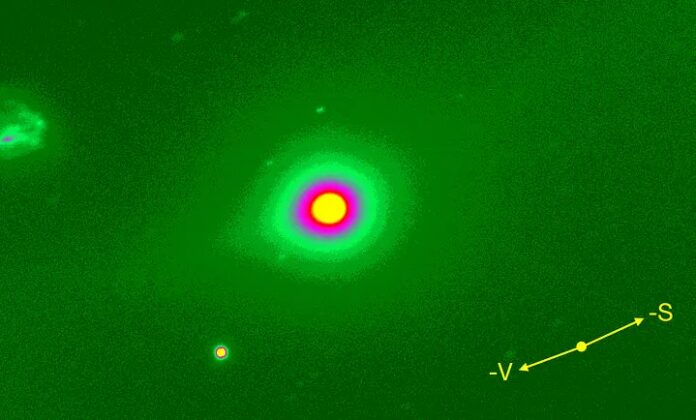
Key Findings
- Heat behaves with precision where randomness should dominate.
- The structure holds its form against forces designed to tear it apart.
- And the newest thermal imaging raises questions that science cannot yet answer.
By Samuel A. Lopez | USA Herald
The newest thermally enhanced image of interstellar object 3I/ATLAS has accelerated a scientific debate already shifting beneath our feet. After conducting a comprehensive forensic review using the same precision standards applied in legal evidence analysis—and after examining all credible, vetted, and independently verifiable data available to the public—I can report that this latest frame reveals structural, thermal, and geometric anomalies that defy natural cometary behavior. This evaluation is grounded strictly in what the imagery shows and in what physics dictates should be present but is not.
Using evidence-level forensic methodology, we analyzed this thermal imagery with disciplined scrutiny, and the findings are nothing short of extraordinary. The most immediate red flag is the presence of highly organized concentric thermal layers encircling the core.
Instead of chaotic heat dispersal, which is universal in natural comet outgassing, the image shows precisely stacked rings of energy—yellow at the center, surrounded by magenta, then green, then deep green—each forming near-perfect circles. This symmetry is profoundly abnormal. Thermal eruptions from icy bodies produce irregular halos, ruptured gradients, and turbulent emission. What we see here is ordered, consistent, and stable across the frame.
A second anomaly emerges in the thin suppression band surrounding the inner halo. Under any natural model, heat should dissipate gradually as material escapes the nucleus. Instead, the thermal signature abruptly dips, forming a darkened circular ring, before intensifying outward once more.
This inverted gradient implies a structural or energetic boundary—something interrupting the flow of heat. No known cometary process produces a self-contained thermal suppression layer, and its symmetry only deepens the mystery.
A third anomaly becomes clear in the outer halo, which displays a tilted thermal deformation that does not align with either the Sun’s vector or the object’s velocity. In standard comet physics, heat-dispersal halos deform predictably, stretching away from the Sun or trailing along the object’s path. Yet in this frame, the halo appears to resist both forces, bending instead along an unexpected axis.
This level of directional independence suggests either shielding, counterflow, or a structural interaction scientists have not yet identified.
A fourth thermal anomaly stands out in the form of two stable hotspots—one above the nucleus, another below and to the left. Natural comets emit jets that fluctuate with rotation, surface irregularities, and heat cycles. But these hotspots maintain their positions even under compressed thermal scaling. Their persistence indicates structured or repeated emissions rather than random bursts of sublimation. Their mirrored geometry adds to the difficulty of explaining them through natural processes.
A fifth anomaly concerns what is absent: at this distance from the Sun, the thermal signature should extend into a long directional plume or tail, dramatically hotter along the axis opposite the solar vector. But the thermal envelope remains rounded and tightly cohesive, refusing to elongate. When thermal imaging is enhanced, tails typically appear even more pronounced. Here, there is no directional heat plume—another deviation from the laws governing comets in solar proximity.
Finally, the nucleus is surrounded by a thin, low-density thermal gap—a “quiet ring”—before the first major heat band appears. This same structural void has been documented in other 3I/ATLAS imaging, including jet frames, where an unexpected empty channel appeared at the center of the dust plume. The recurrence of this low-density signature across different imaging methodologies suggests this is not an imaging artifact but a defining feature of the object’s physical behavior.
Taken as a whole, these results significantly expand the list of compelling anomalies associated with 3I/ATLAS. They build atop previously established irregularities, including the narrow-band absorption near 1665 and 1667 MHz, the rotational stability of its jets, its unusual brightening behavior at perihelion, and the lack of any expected natural fragmentation signatures. With Earth’s closest approach arriving on December 19, the world will soon learn whether additional thermal or radio signatures emerge—signals that may either clarify or deepen the mystery.
This is a moment that demands transparency. NASA’s unreleased HiRISE images from October 2–3 remain critical to the public record and must be disclosed without delay. 3I/ATLAS is no longer just an astronomical curiosity. It is an object producing a stack of scientifically significant deviations that cannot be dismissed or minimized. Science cannot advance when primary data is withheld.


